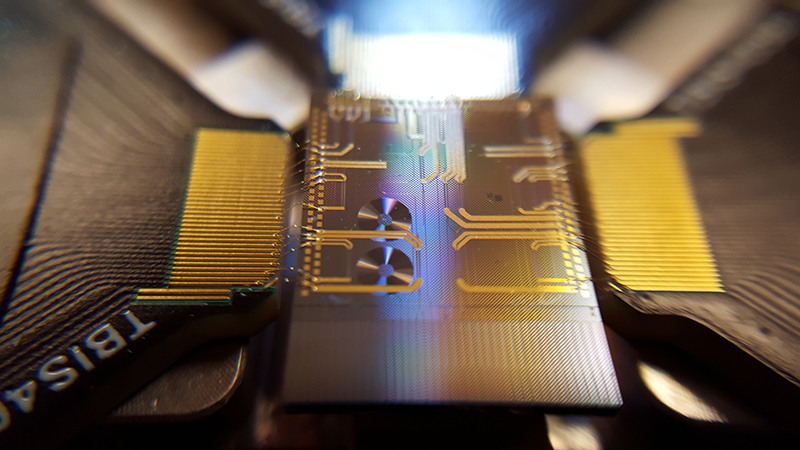December 3, 2018
by Stéphanie Thibault
Using a compact optical platform that exploits the quantum characteristics of light, Professor Roberto Morandotti and his team are one step closer to realizing the first powerful photonic quantum computer. In the journal Nature Physics, the INRS researchers revealed to have generated a particular class of quantum states–d-level cluster states–, as well as to have used them to implement novel quantum operations. The demonstrated states exhibit unique properties that make them more robust and powerful than any other such states demonstrated thus far.
For nearly ten years, Professor Roberto Morandotti has been building an ambitious system piece by piece by developing chips that use light particles (photons) as the data medium. On these coin-sized chip structures, photons are generated and transformed so they can be assigned unique quantum properties. His team was the first to successfully create high-dimensional (i.e. quDit) optical cluster states, one of the elements that can enable the ongoing quest to harness the power of quantum computing.
Electronic computer systems are nearing the limit of their capabilities, yet demand for greater computing power is constantly growing. This is why scientists are turning to quantum computing, investigating how to encode a significant amount of information in light particles and perform calculations of unprecedented complexity.
To get there, the data medium has to be shifted to quantum bits (or qubits), the non-classical computing equivalent of conventional bits. By judiciously designing the quantum state of the photons, it is possible to increase the information storage capacity of qubits and boost them to obtain so-called quDits. Then, by grouping the quDits into clusters, quantum computing operations based on the so called ‘one-way’ scheme become possible.
Other approaches to quantum computing use ions, atoms, or other quantum resources, but the efforts to manipulate them towards a higher-dimensional encoding have been inefficient. According to Professor José Azaña (INRS), an expert of telecommunications who contributed to this research, photons also present another advantage: “They are used to transmit information via optical fibers in existing telecommunications systems. That means photons with controlled quantum properties can also travel through these same channels without losing their attributes.”
The complexity and richness of the cluster states described in the article in Nature Physics is unprecedented. Moreover, the team of researchers also achieved another first by performing high-dimensional quantum computing operations harnessing the realized cluster states.
They demonstrated that light has all the necessary features to power the superfast computers of the future. In a significant leap forward, this was done with a compact system compatible with existing technologies. The platform developed by the INRS team is capable of generating quantum states with complexities sufficient to achieve quantum computing objectives, thus paving the way to one-way quantum computers.
Article highlights
Firsts:
- Generation of high-dimensional cluster states
- D-level operations using cluster states
- Creation of a hyper-entangled state in frequency and time
Advantages of the photonic system:
- Commercially available components
- Compatible with integrated electronics systems
- Compatible with telecommunications systems
- Scalability
- Practical and easy to use
- Inexpensive
- Compact
About the paper
Christian Reimer, Stefania Sciara, Piotr Roztocki, Mehedi Islam, Luis Romero Cortés, Yanbing Zhang, Bennet Fischer, Sébastien Loranger, Raman Kashyap, Alfonso Cino, Sai T. Chu, Brent E. Little, David J. Moss, Lucia Caspani, William J. Munro, José Azaña, Michael Kues and Roberto Morandotti, “High-dimensional one-way quantum processing implemented on d-level cluster states,” Nature Physics, published December 3, 2018, DOI: 10.1038/s41567-018-0347-x.
The research team received financial support from the Natural Sciences and Engineering Research Council of Canada, Ministère de l’Économie, de la Science et de l’Innovation du Québec, Canada Research Chairs, the Australian Research Council, the European Union, the Chinese Academy of Sciences, the John Templeton Foundation, the Government of the Russian Federation, and the 1,000 Talents Program (Sichuan, China).













